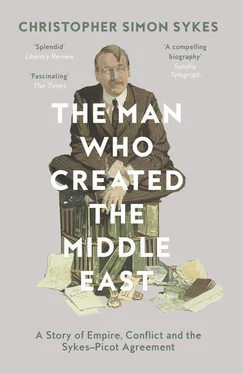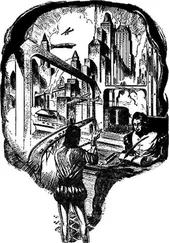Needless to say, Jessie’s mother was thrilled by the arrival of her grandson, as were Jessie’s friends and admirers. In one quarter only was there a singular lack of rejoicing at the birth of a new heir. Christopher Sykes, Tatton’s younger brother, was a sensitive, intelligent and charming bachelor of fifty-one who was MP for the East Riding, and a leading member of the Marlborough House set that revolved round Edward, Prince of Wales. He had been relying on his older brother to bail him out of his financial difficulties, which were the result of the constant and lavish entertaining of his Royal friend, both at his house in London, 1 Seamore Place, and at Brantingham Thorpe, his country home near Hull. The notion that his Tatton would ever marry, let alone sire a son, had never entered his mind, and when he managed both, the first came as a surprise, the second as a shock. ‘C.S.,’ wrote Sir George Wombwell, a Yorkshire neighbour, ‘don’t like it at all.’ 12
Though producing a son and heir had strengthened Jessie’s position immeasurably, she was as restless as ever and the next couple of years saw her indulging in a number of liaisons which set tongues wagging, beginning in 1880 with the dashing Captain George ‘Bay’ Middleton, one of England’s finest riders to hounds. When this flirtation ended, at the end of 1881, she took up with a German Baron called Heugelmüller, a serial womanizer who eventually ran off with her cousin Blanche, Lady Waterford. ‘Oh Blanche, how you have spoilt my life,’ she wrote miserably in her diary in August 1883. ‘He is selfish poor ugly and a foreigner, and yet I like him better than anyone or anything.’ 13Her unhappiness was compounded by the fact that in the summer of 1881 she also suffered a miscarriage. ‘That walk on Saturday, the consequence of so much quarrelling,’ wrote Captain Middleton in August 1881, ‘must have been too much for you, and am very sorry your second born should have come to such an untimely end. Altho’ the little beggar was very highly tried … Goodbye and hoping this will find you strong, but don’t play the fool too soon.’ 14
Jessie’s state of mind was noticed by a new acquaintance she had made, George Gilbert Scott Junior, a young Catholic architect who was working on the restoration of a local Yorkshire church at Driffield. Intrigued by the Sykeses’ strange marriage, and having strong links to the hierarchy of the Catholic Church, he saw them as perfect subjects for conversion. ‘The Baronet is a serious, taciturn, melancholy man, who has no hobby or occupation but church-building,’ he wrote to Father Neville, secretary to Cardinal Newman at Birmingham Oratory. ‘It is his craze and he grudges no money upon it and yet he is not happy. With everything to make life sweet, abundant wealth, fair health, a keen enjoyment of open-air exercise, a splendid house, a noble library, a clever luxuriously beautiful wife, and a promising healthy young son, he is one of the most miserable of men, neglects his wife, his relations, his fellow-creatures generally, lavish in church-building, he is parsimonious to a degree in everything else, leaves his wife, whose vivacity and healthy sensuous temperament throw every possible temptation in the way of such a woman, moving in the highest society, exposed within his protection to the dangers of a disastrous faux pas and all this for want of direction … I want to interest yourself, and through you the Cardinal, in these two. The securance to the Catholic Church in England of a great name, a great estate, a great fortune, is in itself worth an effort … But to save from a miserable decadence two such characters (as I am convinced nothing but the Catholic Faith can do) is a still higher motive and venture respectfully to ask your prayers for their conversion …’ 15
It was in fact a road down which Jessie had been considering going. ‘You have not forgotten that many years ago I told you that I was in heart a Catholic,’ she wrote in a letter to an old friend and Yorkshire neighbour, Angela, Lady Herries, ‘only I had not the moral courage to change my religion.’ After ‘many struggles and many misgivings’, she told her, she was at last ready to embrace the faith, adding, ‘and I shall have the happiness of bringing my little child with me’. 16It was a brave move considering that the Sykeses had been Anglicans since time immemorial, the six churches so recently built by her husband being monuments to their faith. She would have liked to persuade Tatton to join her, but he was reluctant to take the step for fear of offending the Protestant and Methodist villagers of Sledmere, even if he gave her the impression that he would consider doing so. ‘Sir Tatton, who as you know is of a nervous and retiring temperament and who dreads extremely publicity, has decided to wait to make his final profession when he intends he will be at Rome in the end of February.’ 17
Angela Herries, sister-in-law to the Duke of Norfolk, the head of England’s leading Catholic family, was delighted to hear the news of the conversion. It was through her family connections that Jessie had been given an introduction to the Cardinal Archbishop of Westminster, Henry Edward Manning, and she was pleased that he had not wasted the opportunity of adding another wayward soul to his flock. He had indeed taken a very personal interest in Jessie, who bared her soul to him in her letters. ‘Since I returned from London,’ she wrote to him in November 1882, ‘I have thought much and sadly of all the wasted opportunities and the useless and worthless life I have led up to the present time, thinking of nothing but my own amusement, and living without any religion at all for so many years. I sometimes fear that the voice of conscience and power of repentance has died away from me and that I shall never be able to lead a good or Christian life. I feel too how terribly imperfect up till now my attempts at a Confession have been, and how many and grave sins I have from shame omitted to mention …’ 18
With Lady Herries and Lord Norreys acting as her godparents, and Lady Gwendolyn Talbot and the Duke of Norfolk as Mark’s, Jessie and her son were received into the Catholic Church at the end of November. The conversion caused some upset in Sledmere, as Tatton had predicted it would, and in an attempt to soften the blow Cardinal Manning wrote a ‘long and eloquent’ exposition on the subject for the vicar of Sledmere, the Rev. Mr Pattenhorne. Nevertheless, Jessie was riddled with guilt at the unhappiness she had caused to him and his congregation. Her inner struggles continued, and she was devastatingly self-critical in her letters to Manning. ‘I … fear steady everyday useful commonplace goodness is beyond my reach,’ she told him. ‘Honestly I am sorry for this – I have alas! no deep enthusiasm, no burning longings for perfection, no terrible fears of Hell – I am wanting in all the moral qualities and sensations which I have been led to believe were the first tokens and messages of God the Holy Spirit working in the Human heart.’ 19
In taking Mark with her into the Catholic Church, Jessie well and truly staked her claim on him, and there is no doubt that she was the overwhelming influence upon him as he grew up. To her, children were simply small adults who should quickly learn how to stand on their own two feet. As soon as Mark had started to master the most basic principles of language, she began to share with him her great love of literature and the theatre. As well as the children’s books of the day – the fairy tales of Grimm, Hans Andersen and George Macdonald, the stories of Charles Kingsley and Lewis Carroll, the tales of adventure of Sir Walter Scott, James Fenimore Cooper and Robert Louis Stevenson – she read him her own favourites, Swift, Dickens and Shakespeare, much of which she could quote from memory. She encouraged him to dress up and act out plays, and she was delighted when he began to develop a talent for mimicry and caricature.
Читать дальше











